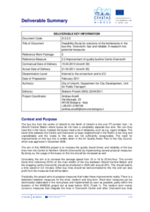Improving bus service quality between the centre and the north
Thematic areas
Collective passenger transport & shared mobility
Summary
Utrecht is concerned about the quality of the bus service between the city centre and the neighbourhood of Overvecht. The city wants to increase the speed and reliability of the bus line.
Implementing sustainable mobility
Utrecht wants to implement various physical measures to provide a better bus connection between the northern neighbourhood of Overvecht and the city centre.
The main objectives of the measure are to:
- improve the quality (travel times) and reliability of the PT connection between the city centre and Overvecht (Northern part of the city);
- increase usage of the buses on this line.
One of the main axes in the public transport network of Utrecht is the bus line connecting Overvecht – a district located in the northern part of Utrecht – with the city centre. The recurrent delays observed on this line imply considerable mobility problems for public transport users. The MIMOSA measure ‘Quality Bus Line’ aimed to improve the service quality of the bus line between the city centre and Overvecht. Based on an extensive analysis of the diverse options for optimisation the focused bus line, a set of short, medium and long term measures was developed, with the objectives to reduce travel times, enhance the reliability of the bus line and increase the number of users on this line.
Progress
Within this analysis problems were inventoried by conducting measurements of the travel times, delays and numbers of passengers, carrying out a survey among more than 300 bus passengers and interviewing four bus drivers. The conclusions of the inventory of problems were the following: The subjective evaluation was quite positive, but objectively there were a large number of bottlenecks on the line. The different interpretation between subjective and objective evaluations can be explained by the fact that the range of travel times was quite broad, which makes the buses seem to travel on time. However, the travel times were too long for the objective of the city: making this PT-route faster (a decrease of the travel time by 2.5 minutes), more attractive and more financially attractive (operation). The main problem identified is the bottlenecks.
Several solutions have been elaborated and summarized in a technical report. One of these solutions was implemented in April 2012: the installation of traffic light prioritisation for the buses on one intersection (Brailledreef and Loevenhoutsedijk).
Most of the elaborated solutions are planed to be fully implemented in a medium or long term. That explains that only the above mentioned solution could be achieved within the CIVITAS MIMOSA period.
Outcomes
Unfortunately, the lack of efficient tools to collect valuable data on travel times did not permit to conduct an impact evaluation. The estimated cost for the design of efficient measurement tools was too high in relation to the available financial resources for the measure. Hence the measure evaluation focussed on the identification of barrier and drivers through the process evaluation. The main barrier was the delays in the implementation due to the interdependence of the Quality Bus Line measure with other measures, like the revitalization of the St. Jacobsstraat (see further) and the development of remote control of the bridges in which the communication between the buses and the bridge keeper – one of the measures in UTR 2.2 - will be taken into consideration.
One of the measure parts – the redesign of the St. Jacobsstraat – raised a significant political interest on the city level which contributed to support the measure. In addition to improving the current bus lines and stations, politicians now want to revitalize the entire area along the St. Jacobsstraat by giving more prominence to public transport and bicycles with the overall aim to integrate the neighborhood to the inner-city of Utrecht. This led to the elaboration of a Functional Design for the entire traffic infrastructure of the St. Jacobsstraat. This politicial interest for the measure is a driver which ensures the support of the Municipality to implement the measure in the long-term.









